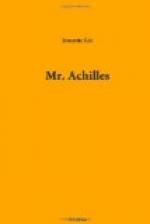He smiled a little, and drew a soft, flat, white bit of tissue from his pocket, undoing it fold on fold—till in the centre lay a grey-green leaf.
The child bent above it with pleased glance. Her eyes travelled to his face.
He nodded quickly. “I thought of you. It is the Eastern citron. See—” He lifted the leaf and held it suspended. “It hangs like this—and the fruit is blue—grey-blue like—” His eye travelled about the elaborate room. He shook his head slowly. Then his glance fell on the grey gown of Miss Stone as it fell along the rug at her feet, and he bowed with gracious appeal for permission. “Like the dress of madame,” he said—“but warmer, like the sun—and blue.”
A low colour crept up into the soft line of Miss Stone’s cheek and rested there. She sat watching the two with slightly puzzled eyes. She was a lady—kindly and gracious to the world—but she could not have thought of anything to say to this fruit-peddler who had seemed, for days and weeks, to be tumbling all Greek civilisation about her head. The child was chatting with him as if she had known him always. They had turned to each other again, and were absorbed in the silken leaf—the man talking in soft, broken words, the child piecing out the half-finished phrase with quick nod and gesture, her little voice running in and out along the words like ripples of light on some dark surface.
The face of Achilles had grown strangely radiant. Miss Stone, as she looked at it again, was almost startled at the change. The sombre look had vanished. Quick lights ran in it, and little thoughts that met the child’s and laughed. “They are two children together,” thought Miss Stone, as she watched them. “I have never seen the child so happy. She must see him again.” She sat with her hands folded in her grey lap, a little apart, watching the pretty scene and happy in it, but outside it all, untouched and grey and still.
VII
To meet the “Halcyon club”
Outside the door the horses pranced, champing a little at the bit, and turning their shining, arching necks in the sun. Other carriages drove up and drove away. Rich toilets alighted and mounted the red-brown steps—hats that rose, tier on tier, riotous parterres of flowers and feathers and fruit, close little bonnets that proclaimed their elegance by velvet knot or subtle curve of brim and crown. Colours flashed, ribbon-ends fluttered, delicately shod feet scorned the pavement. It was the Halcyon Club of the North Side, assembling to listen to Professor Addison Trent, the great epigraphist, who was to discourse to them on the inscriptions of Cnossus, the buried town of Crete. The feathers and flowers and boas were only surface deep. Beneath them beat an intense desire to know about epigraphy—all about it. The laughing faces and daintily shod feet were set firmly in the way of culture. They swept




